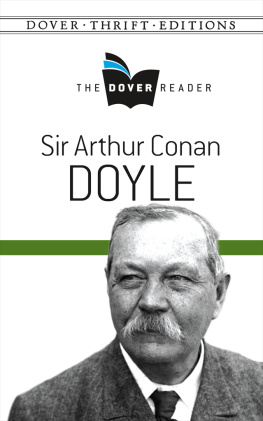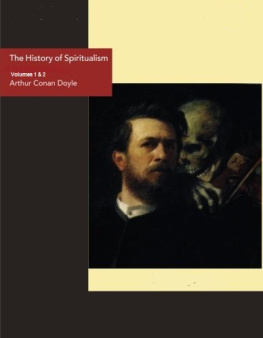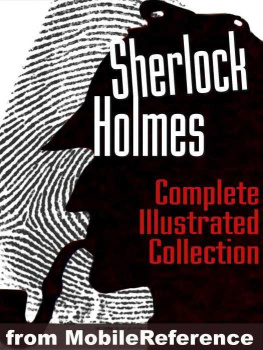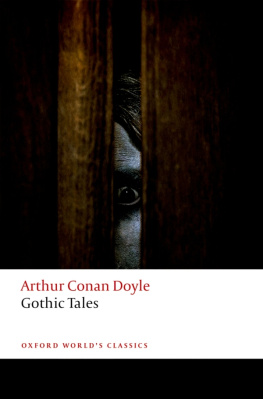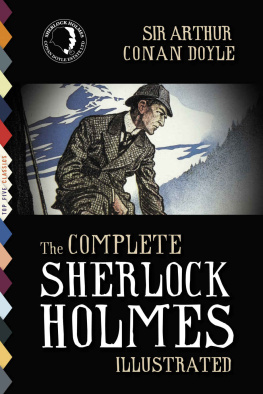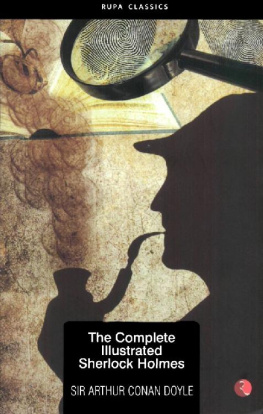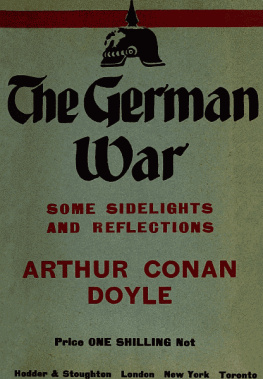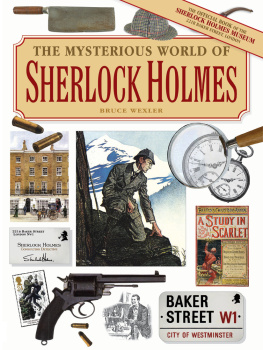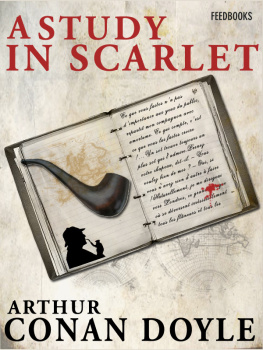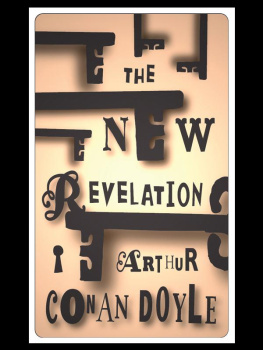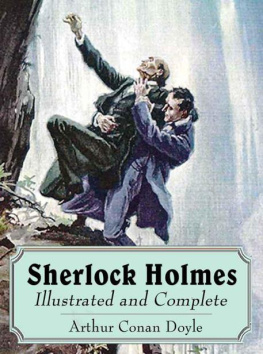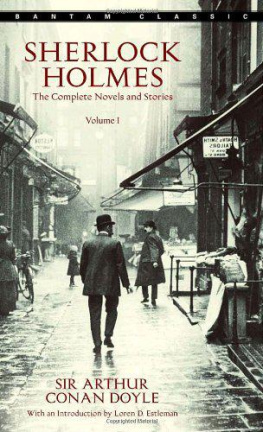
Sir Arthur Conan Doyle

DOVER PUBLICATIONS, INC.
Mineola, New York
DOVER THRIFT EDITIONS
GENERAL EDITOR: MARY CAROLYN WALDREP
EDITOR OF THIS VOLUME: JANET B. KOPITO
Copyright
Copyright 2015 by Dover Publications, Inc.
All rights reserved.
Bibliographical Note
Sir Arthur Conan Doyle: The Dover Reader, first published by Dover Publications, Inc., in 2015, is a new compilation of novels and short fiction by Sir Arthur Conan Doyle reprinted from standard editions.
Library of Congress Cataloging-in-Publication Data
Doyle, Arthur Conan, 18591930.
[Short stories. Selections]
Sir Arthur Conan Doyle : the Dover reader / Arthur Conan Doyle.
p. cm. (Dover thrift editions)
eISBN-13: 978-0-486-80301-2 (pbk.)
I. Title.
PR4621 2015
823'.8dc23
2014033864
Manufactured in the United States by Courier Corporation
79117301 2015
www.doverpublications.com
Note
THIS ANTHOLOGY OFFERS an entertaining selection from the writings of Sir Arthur Conan Doyle. Conan Doyles best-known literary creation, Sherlock Holmes, is represented by The Hound of the Baskervilles, a lengthy exploration of the legend of a ghostly hound; another extended work, A Study in Scarlet, the first of Conan Doyles Holmes stories and an immediate success; and two short stories, A Scandal in Bohemia and The Final Problem. The Lost World, an adventure fantasy set in the Amazon, marks the first appearance of Professor George Edward Challenger, a zoologist who embarks on a scientific expedition that includes an encounter with live dinosaurs; and two supernatural tales, The Ring of Thoth and The Los Amigos Fiasco.
One of ten children, Arthur Ignatius Conan Doyle was born in Edinburgh on May 22, 1859. He was sent to Jesuit schools (although he soon disavowed Catholicism) and attended college, studied medicinebecoming a ships doctor as well as an ophthalmologistand, after some publishing successes, devoted himself to writing, a pursuit he had begun to raise tuition money while a medical student. He published his first work featuring the iconic Sherlock Holmes and Dr. Watson, A Study in Scarlet, in 1887. Holmes, appearing in four Conan Doyle novels and more than fifty short stories, has been portrayed in many television programs and movies. The success of this fictional character and his exploits, however, led the author to spend more time on his famed detective than he wished. Praised by critics for his historical novels and political studies, Sir Arthur Conan Doyle nevertheless is universally identified as the creator of the brilliant and tormented inhabitant of 221B Baker Street, London: Sherlock Holmes.
Contents
Sir Arthur Conan Doyle
The Dover Reader

Sherlock Holmes

A STUDY IN SCARLET
A STUDY IN SCARLET
PART 1
BEING A REPRINT FROM THE
REMINISCENCES OF JOHN H. WATSON,
M.D. , LATE OF THE ARMY MEDICAL
DEPARTMENT
CHAPTER 1
MR. SHERLOCK HOLMES
IN THE YEAR 1878 I took my degree of Doctor of Medicine of the University of London, and proceeded to Netley to go through the course prescribed for surgeons in the Army. Having completed my studies there, I was duly attached to the Fifth Northumberland Fusiliers as assistant surgeon. The regiment was stationed in India at the time, and before I could join it, the second Afghan war had broken out. On landing at Bombay, I learned that my corps had advanced through the passes, and was already deep in the enemys country. I followed, however, with many other officers who were in the same situation as myself, and succeeded in reaching Candahar in safety, where I found my regiment, and at once entered upon my new duties.
The campaign brought honours and promotion to many, but for me it had nothing but misfortune and disaster. I was removed from my brigade and attached to the Berkshires, with whom I served at the fatal battle of Maiwand. There I was struck on the shoulder by a Jezail bullet, which shattered the bone and grazed the subclavian artery. I should have fallen into the hands of the murderous Ghazis had it not been for the devotion and courage shown by Murray, my orderly, who threw me across a pack-horse, and succeeded in bringing me safely to the British lines.
Worn with pain, and weak from the prolonged hardships which I had undergone, I was removed, with a great train of wounded sufferers, to the base hospital at Peshawar. Here I rallied, and had already improved so far as to be able to walk about the wards, and even to bask a little upon the veranda, when I was struck down by enteric fever, that curse of our Indian possessions. For months my life was despaired of, and when at last I came to myself and became convalescent, I was so weak and emaciated that a medical board determined that not a day should be lost in sending me back to England. I was despatched, accordingly, in the troopship Orontes, and landed a month later on Portsmouth jetty, with my health irretrievably ruined, but with permission from a paternal government to spend the next nine months in attempting to improve it.
I had neither kith nor kin in England, and was therefore as free as airor as free as an income of eleven shillings and sixpence a day will permit a man to be. Under such circumstances I naturally gravitated to London, that great cesspool into which all the loungers and idlers of the Empire are irresistibly drained. There I stayed for some time at a private hotel in the Strand, leading a comfortless, meaningless existence, and spending such money as I had, considerably more freely than I ought. So alarming did the state of my finances become, that I soon realized that I must either leave the metropolis and rusticate somewhere in the country, or that I must make a complete alteration in my style of living. Choosing the latter alternative, I began by making up my mind to leave the hotel, and take up my quarters in some less pretentious and less expensive domicile.
On the very day that I had come to this conclusion, I was standing at the Criterion Bar, when someone tapped me on the shoulder, and turning round I recognized young Stamford, who had been a dresser under me at Barts. The sight of a friendly face in the great wilderness of London is a pleasant thing indeed to a lonely man. In old days Stamford had never been a particular crony of mine, but now I hailed him with enthusiasm, and he, in his turn, appeared to be delighted to see me. In the exuberance of my joy, I asked him to lunch with me at the Holborn, and we started off together in a hansom.
Whatever have you been doing with yourself, Watson? he asked in undisguised wonder, as we rattled through the crowded London streets. You are as thin as a lath and as brown as a nut.
I gave him a short sketch of my adventures, and had hardly concluded it by the time that we reached our destination.
Poor devil! he said, commiseratingly, after he had listened to my misfortunes. What are you up to now?
Looking for lodgings, I answered. Trying to solve the problem as to whether it is possible to get comfortable rooms at a reasonable price.
Thats a strange thing, remarked my companion; you are the second man to-day that has used that expression to me.
Next page
